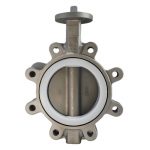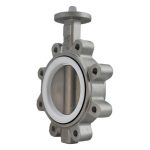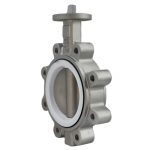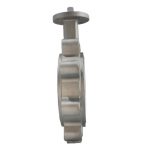II. Key Attribute Specifications
A. Dimensional & Pressure-Temperature Parameters
- Nominal Diameter (Port Size): DN125 (5 inches), a widely utilized size in medium-scale industrial pipelines. This dimension balances flow capacity and installation flexibility, making it ideal for process lines in chemical reactors, pharmaceutical blending systems, and water distribution networks.
- Pressure Rating: PN16 (1.6MPa), aligning with industrial medium-pressure requirements. The valve undergoes hydrostatic testing at 1.5× rated pressure for the body and 1.1× rated pressure for the seat, ensuring structural integrity and leak-tight sealing under operating conditions.
- Temperature Range: -20℃ to 180℃, enabled by the PTFE lining’s thermal stability and CF8M stainless steel’s resistance to thermal stress. This range accommodates cryogenic fluids, ambient media, and moderately heated corrosive chemicals, ensuring versatility across applications.
B. Material Composition
- Valve Body & Disc: CF8M stainless steel (ASTM A351), containing 16–18% chromium, 10–12% nickel, and 2–3% molybdenum. This alloy offers superior corrosion resistance to chlorides, acids, and alkalis compared to 304 stainless steel, making it indispensable for marine, chemical, and pharmaceutical environments.
- Sealing Lining: PTFE (polytetrafluoroethylene) lining on the valve body and seat, providing chemical inertness to nearly all industrial chemicals, solvents, and food-grade media. The lining thickness is precision-controlled to ensure uniform coverage and sealing performance.
- Valve Stem: 17-4PH stainless steel, heat-treated for strength and corrosion resistance, with an anti-blowout design to meet safety standards.
- Gaskets & Packing: PTFE or EPDM gaskets (food-grade compliant) and PTFE-impregnated packing ensure compatibility with corrosive and sanitary media.
C. Connection & Operational Features
- Connection Type: Lug-type flange (ANSI B16.5), allowing for bolt-through installation that simplifies alignment and eliminates the need for pipeline rotation during valve maintenance. Lug-style connections are also ideal for retrofitting into existing systems, as they can be installed between standard flanges.
- Operation Mode: Manual (lever or gear operator) as standard, with options for electric, pneumatic, or hydraulic actuation for automated control. A lever operator on a DN125 valve enables quick on-off operation, while gear operators reduce torque for ease of use in high-pressure scenarios.
- Safety & Compliance Features: API 609-compliant design, with optional fire-safe and low-emission configurations. The valve is marked with permanent identification for material traceability and compliance with industry regulations.
D. Certifications & Compliance
- Industry Standards: API 609, ASME B16.5, ISO 5752, ISO 9001.
- Material Certifications: ASTM A351 (CF8M), ASTM A564 (17-4PH).
- Regional Approvals: CE, FDA (for food-grade applications), and ATEX (optional for hazardous environments).
III. Feature Description
A. Midline (Centric) Design: Uniform Sealing & Flow Efficiency
B. CF8M Stainless Steel Construction: Corrosion Resistance in Harsh Environments
C. Lug-Type Flange Connection: Installation Flexibility & Maintenance Ease
- Bolt-Through Installation: Lug flanges are drilled to allow bolts to pass through the valve and into the pipeline flanges, simplifying alignment and reducing installation time. This is especially beneficial in confined spaces or when retrofitting into existing pipelines.
- Isolation Capability: Lug valves can be installed with blind flanges on one side, enabling easy isolation for maintenance without disrupting the entire pipeline system. In a pharmaceutical batch processing line, this feature allows for quick valve replacement or inspection, minimizing downtime.
- Compatibility: Lug flanges conform to ASME B16.5, ensuring compatibility with standard pipeline flanges from other manufacturers. This interchangeability reduces inventory costs and streamlines procurement for multi-vendor projects.
D. PTFE Lining: Chemical Inertness & High-Temperature Stability
E. Soft-Sealed Performance: Bubble-Tight Leakage Control

IV. Manufacturing Processes
A. Material Inspection & Preparation
- CF8M Verification: Raw material billets undergo spectral analysis to confirm chemical composition (Cr: 16–18%, Ni: 10–12%, Mo: 2–3%) and ultrasonic testing to detect internal defects. Mechanical testing (tensile, impact) ensures compliance with ASTM A351 standards.
- PTFE Lining Material Testing: PTFE sheets are tested for density, tensile strength, and chemical resistance to ensure they meet FDA and industrial-grade requirements.
B. Valve Body & Disc Machining
- Casting: The valve body and disc are produced via investment casting for CF8M stainless steel, ensuring dimensional accuracy and a smooth surface finish. Castings are solution-annealed to restore corrosion resistance.
- Machining: CNC turning and milling centers shape the body, disc, and lug flanges. Flange faces are machined to flatness tolerance ≤0.05mm/m and surface finish Ra ≤3.2μm for proper gasket seating. The disc’s sealing edge is precision-ground to ensure uniform contact with the PTFE lining.
C. PTFE Lining Application
- Preparing the Substrate: The valve body and seat surfaces are sandblasted to create a rough texture, enhancing PTFE adhesion.
- Lining Application: PTFE is applied via spray coating or press-fitting, depending on the valve size and complexity. For a DN125 valve, the lining thickness is typically 2–3mm, with a tolerance of ±0.2mm to ensure uniform coverage.
- Curing: The lined valve is heated in an oven to cure the PTFE, ensuring it bonds securely to the stainless steel substrate.
D. Assembly & Testing
- Component Assembly: The disc, stem, and sealing components are assembled into the valve body. The stem is torqued to ensure proper disc alignment and sealing pressure.
- Hydrostatic Testing: The valve undergoes shell and seat tests at 1.5× and 1.1× rated pressure, respectively, with no leakage allowed.
- Operational Testing: The valve is cycled 100 times to verify smooth operation, torque consistency, and seal integrity. Leakage is measured using a bubble counter to confirm ANSI/FCI Class VI performance.
V. Product Advantages
A. Unmatched Corrosion Resistance
B. Versatile Lug-Type Installation
C. Bubble-Tight Sealing
D. Energy-Efficient Flow Control
E. Cost-Effective Longevity
VI. Product Applications
A. Chemical Processing
- Acid/Alkali Handling: Controls flow of sulfuric acid, hydrochloric acid, sodium hydroxide, and other corrosive chemicals in reactors, storage tanks, and transfer lines.
- Solvent Recovery: Regulates flow of organic solvents (e.g., ethanol, acetone) in distillation and recycling systems, with PTFE ensuring chemical inertness.
B. Pharmaceutical & Biotechnology
- API Manufacturing: Handles active pharmaceutical ingredients (APIs) and process fluids in sterile environments, with FDA-compliant PTFE and CF8M ensuring product purity.
- Clean-in-Place (CIP) Systems: Controls flow of cleaning agents (e.g., nitric acid, sodium hypochlorite) in sanitary processing lines, resisting corrosion and maintaining hygiene.
C. Food & Beverage Industry
- Beverage Production: Regulates flow of juices, carbonated drinks, and dairy products in bottling and processing lines, with PTFE meeting FDA food contact standards.
- CIP for Food Processing: Handles cleaning solutions in meat, poultry, and dairy facilities, ensuring sanitary conditions and corrosion resistance.
D. Water Treatment & Desalination
- Seawater Desalination: Controls flow of seawater and brine in reverse osmosis systems, with CF8M resisting chloride-induced corrosion.
- Wastewater Treatment: Manages flow of corrosive effluents in chemical and industrial wastewater plants, preventing system degradation.
E. General Industrial Applications
- Pulp & Paper: Controls flow of bleaching agents (e.g., chlorine dioxide) in paper manufacturing, with PTFE resisting chemical attack.
- Marine & Offshore: Regulates seawater and ballast water in marine vessels and offshore platforms, with CF8M ensuring long-term corrosion resistance.
VII. Summary & Customization
RELATED
-

High Temperature/Pressure 304 Stainless Steel Resistant Manual Power Forged Three Piece Flanged Floating Ball Valve
TIANYU 304 Stainless Steel Flanged Floating Ball Valve: Corrosion-Resistant Full-Port Flow Control Solution for Industrial, Sanitary, and Municipal Me…
BALL VALVE 11/03/2025 -

API ANSI 2in-16in DN50-DN400 PN10 PN16 CF8M Pneumatic Flanged Floating Ball Valve
TIANYU CF8M Pneumatic Flanged Floating Ball Valve: 2in-16in (DN50-DN400) PN10-PN16 API/ANSI Class Corrosion-Resistant Flow Control Solution for Indust…
BALL VALVE 11/01/2025 -

Large-Diameter DN1400 CLASS150 WCB SS Triple Eccentric Metal-Sealed Hard Seal Butterfly Valve
TIANYU DN1400 (56″) CLASS 150 WCB Hard Seal Butterfly Valve: Triple Eccentric Metal-Sealed Flanged Valve for Large-Diameter Industrial Media wit…
BUTTERFLY VALVE 10/30/2025 -

PN16 Stainless Steel Floating Ball Valve: Full Port 2PC Flange-Connected Valve with Fire-Safe & Anti-Static SS Ball Valve
TIANYU Stainless Steel Floating Ball Valve: Full Port 2PC Flange-Connected Valve with Fire-Safe & Anti-Static Design for Oil, Gas, and Industrial …
BALL VALVE 10/29/2025 -

High-Performance DN80 Class 150 WCB Soft-Sealed Lug-Type Double Eccentric Butterfly Valve
TIANYU 3” Class 150 WCB lug-type double eccentric butterfly valve is a technologically advanced flow control device engineered to address the challeng…
BUTTERFLY VALVE 10/25/2025 -

API6D ASME DN100 PN16 CF8/316L stainless steel Electric Actuator Motorized Floating Ball Valve For Normal Temperature Water
TIANYU DN100 PN16 CF8 Electric Actuator Motorized Ball Valve: Stainless Steel Flanged Full-Port Flow Control Solution for Industrial Media with Automa…
BALL VALVE 10/24/2025







